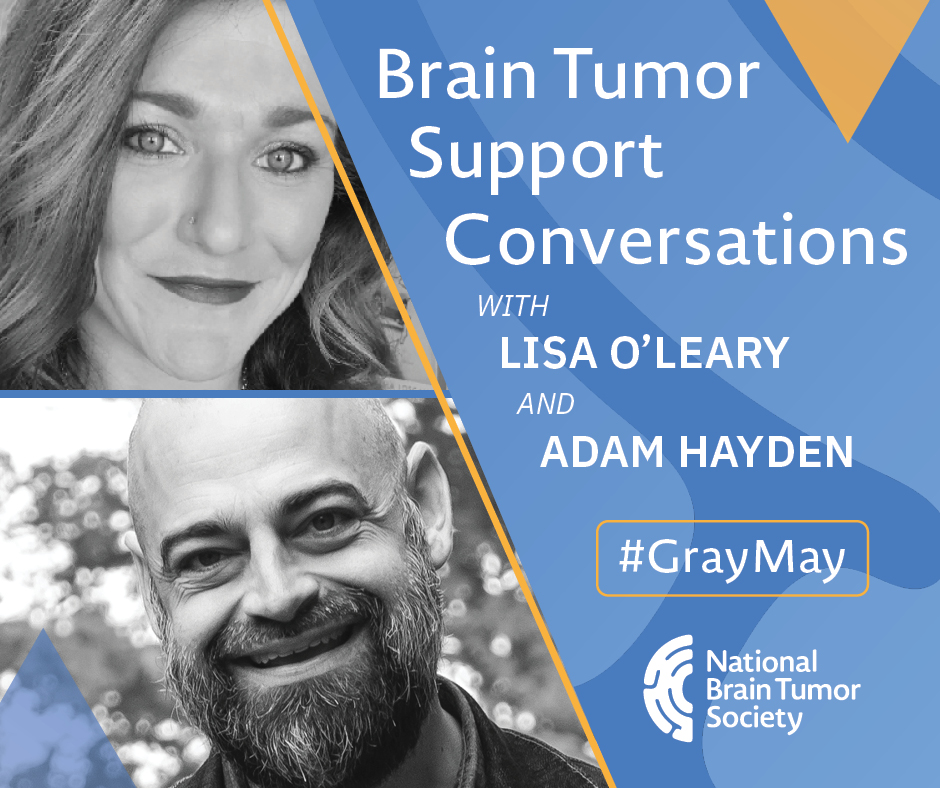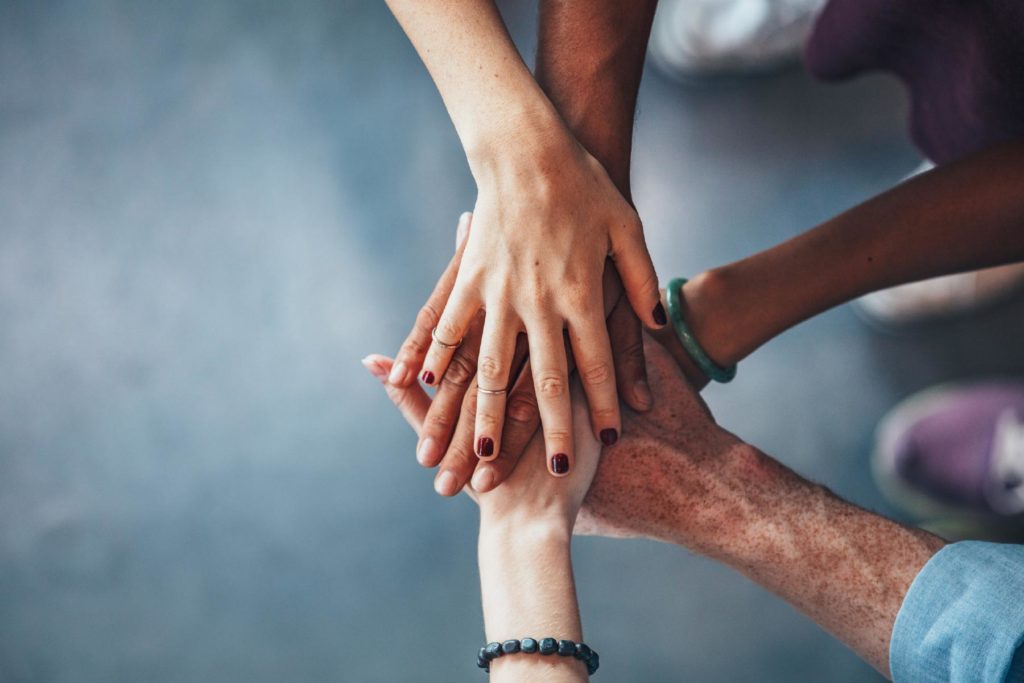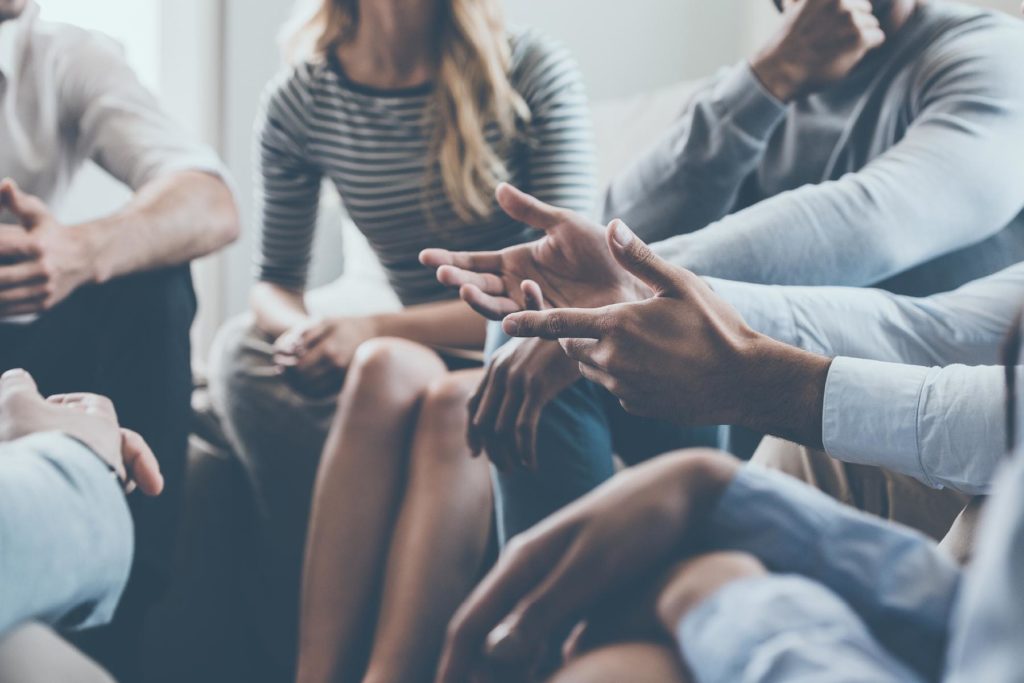This #GrayMay, we come together for Brain Tumor Awareness Month, a month dedicated to supporting, empowering, and amplifying the voice of the brain tumor community. National Brain Tumor Society’s Brain Tumor Support Conversations (BTSC) is a monthly virtual support group where patients and care partners can talk about the feelings and emotions that accompany any aspect of the brain tumor experience in a welcoming space.
Co-founders and volunteer facilitators, Adam Hayden and Lisa O’Leary, have had firsthand experience with the challenges and effects of a brain tumor diagnosis.
In the conversation below, Adam and Lisa share their personal stories and why community support is so important for brain tumor patients and care partners. They also discuss how to connect with the brain tumor community and what to expect at a Brain Tumor Support Conversations session.
Briefly share your brain tumor story and how you initially got involved with NBTS.
Adam: I was diagnosed with GBM in June 2016. My hospital provided an education folder with information about chemo, radiation, Optune, etc., and in that folder was an NBTS informational pamphlet. At that time, I came across someone named Liz Salmi, and I saw that she was involved wth NBTS. Liz and I shared a lot of common interests, so I figured if she was volunteering with NBTS then I should too!
Lisa: In Sept. 2014, in the middle of the night I found my husband Patrick sitting on the floor in our living room, talking but all that came out was gibberish. Not knowing that he had a brain tumor near the language center of the brain and that he was experiencing aphasia from a focal seizure, I called 9-1-1. The paramedics thought he was having a stroke, and he had two grand mal seizures on the way to the hospital. Long story short, it took some time and trauma before his tumor was actually identified. Following his surgical resection, Patrick was diagnosed with glioblastoma — the same type of tumor that killed his sister 11 years earlier.
Patrick’s disease course and treatment were fast and brutal. He spent five months as an inpatient in the hospital trying to control his focal seizures, which caused him to suffer from postictal psychosis — sometimes for a few hours and sometimes for a few weeks. We got married on May 24, 2015, shortly after he made the decision to stop active treatment and start hospice care. Forty-eight days later, I held his hand as he died.
For about a year, I never wanted to hear the words “brain tumor” again, having been diagnosed with severe PTSD. Eventually, I realized that sharing my experience could help other people feel less alone while going through the most harrowing experience of their lives.
What led you both to become co-facilitators of Brain Tumor Support Conversations?
Adam: Lisa and I had attended a conference together in Chicago. We were already pals, but I think that conference showed us the power of patient advocacy and the gaps in support. We were both looking to do more. NBTS approached us later about hosting a group with NBTS, and the Brain Tumor Support Conversations were born!
Lisa: Adam and I were both involved in several different aspects of advocacy and involvement in the brain tumor community. We became close friends and a safe place for the other to talk about “the feels” as we like to call them, meaning all the emotional challenges that come along with the brain tumor experience. NBTS later asked us if we would like to have the opportunity to work with them, giving us a greater ability to reach more members of our community. We were thrilled to be able to start the group with NBTS.
How do support groups like BTSC help brain tumor patients and care partners find community?
Adam: After diagnosis at 34 years old, in a medium-sized city in the Midwest, there just aren’t many support options. Add to this my mobility impairments following surgery, my lifeline to the brain tumor community is and was online. Regardless of a patient or care partner’s location geographically or accessibility concerns, virtual groups offer patients, care partners, and families an way to connect with the community. We bring the community to you!
Lisa: For me, one of the hardest parts of my experience as a care partner to Patrick was feeling so incredibly alone. Patrick was very private, and I knew he did not want to share the ugliness of the day-to-day experience for us, so I did not have much support. I read a couple of books about caring for brain tumor patients, but I had little to no engagement with anyone who really knew what I was going through. BTSC gives people a place to talk about things in a language we all understand.
What topics come up in a support group like BTSC? What can someone expect from participating in a session?
Adam: The first several minutes — sometimes the first half of our meetings — are devoted to sharing recent events or upcoming events that are significant to our attendees. Maybe this is a recent diagnosis, the results of a recent scan, an upcoming milestone like an anniversary, and occasionally attendees share things like a child’s birthday or a special holiday that they are looking forward to celebrating. Often folks look to hear from others about their experiences managing fatigue or tips on handling stress. Sometimes we have to remind participants that we’re here to share experiences and not medical advice when questions come up about specific treatments or symptoms, but we try our best to create a virtual space for people to share what is on their hearts in each meeting. It’s a very “let’s get into the feels” type of space.
Lisa: Most of the time, Adam and I start the meeting by discussing any milestones, celebrations, or other significant events that people have going on. This might be an upcoming scan or the results of a recent one, the anniversary of the death of a loved one, a new treatment protocol, etc. Then, at times, we go to topic-based discussions whether it is getting through the holidays or what Brain Tumor Awareness Month means to our participants. Often, we are led by topics that come up during our milestones discussion. Overall, we aim to talk about the emotional impact of a brain tumor diagnosis, treatment course, and, unfortunately at times, the aftermath following the loss of a loved one.
What recommendations would you give to someone hoping to connect more?
Adam: Within the context of the support group, we’ve witnessed many ongoing friendships develop from the group and live on outside of it. We often have requests for participants to swap contact information, and we make sure to get consent before doing so. We have several folks who became friends after meeting each other in the group setting. This is so rewarding for everyone!
I’d say other ways to find community are within social media settings, like the Twitter Brain Tumor Social Media (#BTSM/@BTSMChat) community or in Facebook groups. There is a sort of “buyer beware” caveat with online chats and groups. The information may be moderated by administrators, but the information is not often medically vetted, so that is something to look out for.
Lisa: The first way I got involved with the brain tumor community was by using Google to find an organization that had events I might be able to support in California. There was an NBTS fundraiser walk coming up, and I contacted the program director to ask how to help. I continued to research NBTS and traveled to Boston for the second annual Grey Gala — my first time both in Boston and at a gala — and met many of the staff members who provided different ways to get involved.
Social media, with all its flaws, can be a really great way to connect to other patients or care partners. There are monthly events, discussions, and other virtual ways to interact with the community. Some of my best friends today are people I initially met through the online brain tumor advocacy community.
Why is it important to find community during your brain tumor experience?
Adam: Our physicians and care teams are experts in our diseases, but patients and care partners are experts in the experience of having a serious illness. If we limit our illness management to only the clinical side of the equation, we may find ourselves feeling lonely, distressed, and discouraged. When we join in community we immediately feel the warmth of a community who “gets it.” For example, I have persistent focal seizures — this has been a really tough symptom for me to manage — but when I spend time in community, I hear that others have this difficult symptom, too. Even though we may all be struggling with something that may not be easilyresolved, the knowledge that we are struggling together is powerful.
Lisa: As I mentioned before, I felt incredibly alone during my time as a care partner. I often wonder if I had support while going through that trauma whether I would have felt better prepared, known more what to expect, and would not have had such huge interruptions in my ability to move forward following Patrick’s death.
How have you personally benefited from the support of the brain tumor community?
Adam: My experience in the brain tumor community is summed up by the slogan many of us have adopted in one form or another: We are the greatest family that none of us ever wanted to join. I am fortunate to have a very close partnership with my wife, and we each are close with our extended families. Despite the love I give and receive from many people in my life, no one gets me like the brain tumor community. We’re connected on a level that others just aren’t.
Lisa: I think that identification is one of the most important ways to connect to our fellow human beings, regardless of the topic. Specifically with respect to the brain tumor community, knowing that I am not the only one who has suffered from both emotional and physical impacts of the stressors of being a full-time care partner has helped me feel less isolated and detached from others. The friendships that began as fellow brain tumor community members have developed into some of the deepest and most meaningful relationships I have ever had in my life. The brain tumor community has also supported my own struggles with chronic pain and illness in the wake of Patrick’s death.
Any additional advice, tips, or tools you would like to share about getting connected?
Adam: Be yourself! Among the “general population,” that is, people without brain tumors, there is often an expectation of how patients should look or how care partners should act and feel. When you’re in the brain tumor community, my best advice is to be yourself. With us, it’s one of the places where you truly can be yourself.
Lisa: My best advice is don’t wait to find your people. After Googling “glioblastoma” and seeing the survival rates, I avoided any possible available resources because I was not prepared to hear more. However, BTSC and other advocacy involvement has become a beacon of hope in my life, and often keeps me going when all else fails. Brain tumors impact the patient and their loved ones forever. It does not end if the life of the patient does. Having people who understand at a level no one who has not been through it can is invaluable, and it has been life-saving for me over these many years.
Support groups can be a great comfort to brain tumor patients and caregivers at each stage of their unique experience. Join Adam and Lisa at our next Brain Tumor Support Conversations session this Sunday, May 15, at 7pm ET. You don’t have to go through this process alone, so register today and join a welcoming community of peers who truly understand the brain tumor experience.





